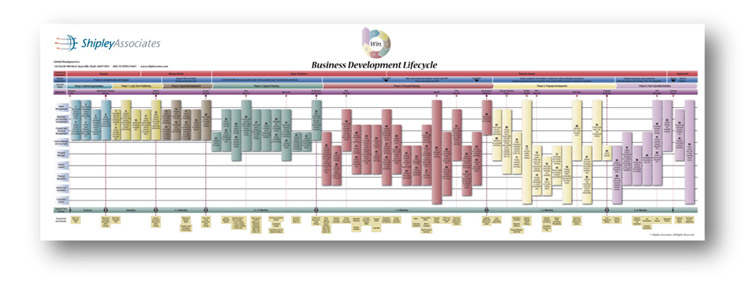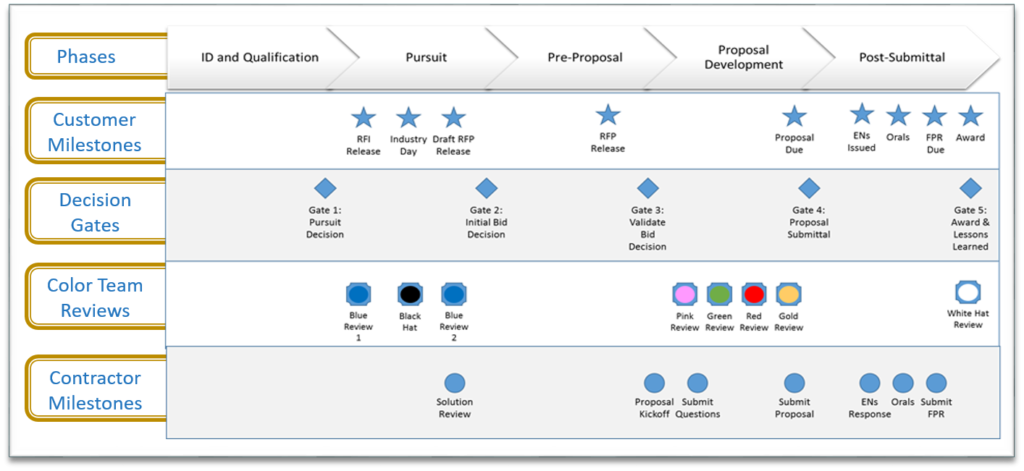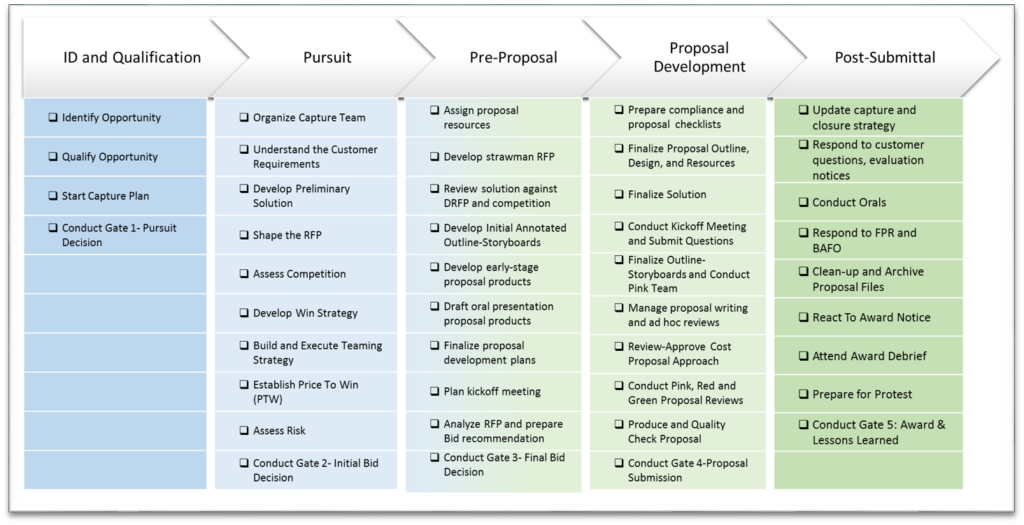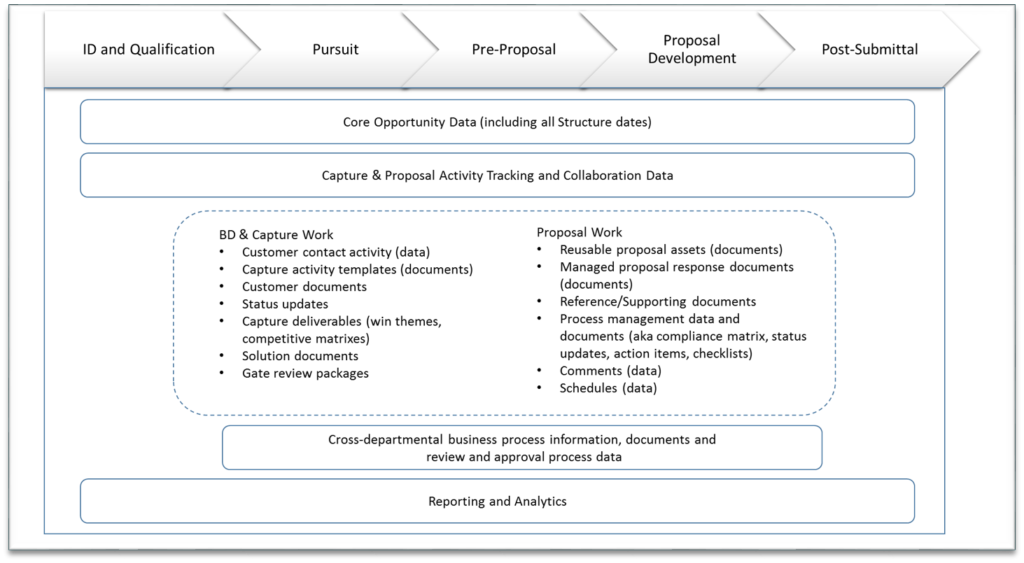The process of winning Federal Government business via RFPs is very well understood and supported by the Government Contractor community. There is an industry standard GovCon Business Development Lifecycle (GovCon BDL). Beginning in the late 1990’s a full lifecycle was codified by Shipley Associates and then became part of the curriculum of the newly formed APMP (Association of Proposal Management Professionals). It has since evolved, become widely supported and adapted by business consulting organizations and adopted by many GovCon and general commercial organizations.
The fundamental challenge is that the Shipley BD model is theory. It’s on paper. So, how do you turn the BD model into something practical that can be managed in the real-world workplace? How do you “operationalize” the model?
In addition, the Shipley BD model and almost all of the best practices being taught to support it focus on winning a single RFP. In the real-world organizations work on multiple opportunities at the same time. So, how do you take a model set up for a single opportunity and apply it in the real-world where you are managing across multiple opportunities?
In this article, we will walk you through 3 Steps to “operationalize” the Shipley BD model in a practical way. By operationalize we mean take if from paper and make it actionable in a modern workplace. The article is for those of you that believe in the basic approach of the model and want to be able to drive the BD, capture and proposal work across your organization in a consistent manner. The objective is to show you how the work can be made more consistent and be more manageable across multiple opportunities. At the end you’ll be able to see how R3 has done this by embedding the best practices into our R3 WinCenter business solution.
Step 1: Understanding GovCon BD Model
The GovCon Business Development Lifecycle provides us with a Phase-based process model and steps and activities to follow to win business through complex RFPs. Shipley Associates provides a very cool, interactive web layout of the lifecycle (click here for Shipley’s online Business Development Lifecycle). Of course this model is supported by lots of documentation, best practices and training by many organizations.
The graphic below is a high level view of the 7 Phases of the Shipley BD model.

As above, however, the BD model itself is conceptual. Organizations don’t follow the model exactly; it is almost always modified.
So, how do you take a process model and put it into practice in the real world of people, information and tools?
Step 2: Breakdown
R3 wanted to create a software solution that would incorporate the basic elements of this BD model to support GovCon organizations. To get there, we had to go through the step of breaking down the beautiful conceptual model into elements that could be managed.
In the article Breaking down the GovCon Business Development Lifecycle to make it Manageable we walk you through the process we went through and what the results were.
It ended up that we were able to break down the model into 3 standard outputs that we call 1) Structure, 2) Work and 3) Information. We will briefly cover each of these below. Refer to the article for more in-depth discussion of each element.
The Structure (based upon dates of things)
The BD model is a Phase-based process model. The Phases of the BD model are the organizing element. Everything relates to the phases. The Structure part of the BD model breakdown consists of 5 element types as shown below. It all revolves around a schedule and a set of items with dates. The element types are:
- Phases – the overall organizing element (5)
- Customer Milestones – the key milestones of the customer with formal dates (9)
- Decision Gates – the events where decisions are made to move an opportunity to the next Phase (5)
- Color Team Reviews – best practice for team reviews of work, each with a color name reflecting a specific purpose (8)
- Contractor Milestones – internal milestones that the contractor team must meet to win business (7)
Note: We use 5 phases below. The full Shipley model has 7 phases. The first 2 phases are before a specific opportunity is identified. In our breakdown we just concern ourselves with the 5 phases where you are working on identified opportunities.
It all comes together as shown below in the one schematic. There are 5 Phases and 29 items that you need to manage across 5 element types. By element I mean a category like Customer Milestone. By item I mean one thing to manage such as the RFI Release date.
Presented in this way, it looks pretty simple. Note that every item is a placeholder for a date. But, the items are always in the same place and relate to the same Phase. Thus, this gives you Structure for the schedule of any given opportunity. Note that your organization may have some different items and put them in different places. That is fine. But, the approach and output is the same.

The Work (standardized BD, Capture & Proposal activities)
With the Structure in place, we know what key events need to occur to move the process forward and when. The guts of the BD model are the standardized BD, Capture & Proposal Activities (“Activities”) that make up the real work. Shipley calls them Steps. We call them Activities. Most documented BD models in use specify the C&P Activities and where they occur in the Phases of the lifecycle. Shipley documents 96 C&P Activities that are part of their 7-phase BDL. Lohfeld typically trains on 72 activities of their 5-phase BDL. Every GovCon organization using a standard BD model has a documented list of their own.
Why is this important? Because this is the list of the real work that leads to success. The better your organization is at executing each of these activities, the more successful you will be at winning business. So, organizations and consulting firms provide standards, tools and best practices for getting the work done on each of the standard C&P Activities.
Below we show you a list of 44 of the standard C&P Activities. Each Activity is slotted to occur within a given Phase. Note that below we simply put the Activity into a Phase. In practice, the Activities start and end at different times. So, in practice there are few start and end dependencies. You just need to get all or most of them done within a given Phase. It is a much simpler view of the model and fits nicely with the Phase based nature of the BD model.

The Information
To do the work, you need to assume that you will capture and use information. Below is a schematic of the key information elements across the phases of the BD lifecycle that are commonly used in the process.
A key assumption of the Shipley model and most best practices is that you are working in a perfect world with access to all of the information that you need. Unfortunately, the reality for most organizations using the Shipley model is that the information used in the process is typically segmented into many systems, data sources or peoples heads. This is a fundamental problem when it comes to making the BD model work in the real world.

Step 3: Making it Manageable (Operationalize it)
With the breakdown above we have simplified the elements of the Shipley model. You can think of it as simply as this:
- The Structure has dates in groups
- The Work has activities that are tasks to do
- All dates and tasks relate to a Phase
- You need to capture information and have access to it along the way
Now, you need to take this breakdown and put it into practice in the real world of work. This means figuring out how to make it manageable with your people, their tools and your information sources. This is what we call operationalizing the model.
We know that each opportunity will have dates and activities. However, the objective is to manage the work so that you have consistency across opportunities.
Working with Dates
So, with Dates you want to break them into elements. Imagine that you were using a spreadsheet. You’d have tabs for each element such as:
- Customer Milestones
- Color Review
- Gate Reviews
- Internal Events/Milestone Actions
The objective is to be able to manage each element for a portfolio of opportunities. So, you’d have all of the customer milestones for all opportunities on the one tab of your spreadsheet.
With the dates organized in this way you can then put them in calendars. You can also build processes to manage the work they way that you need to. You might have a certain way that you do Gate Reviews. Or, you will have a tool and/or method for doing Pink Team or Red Team Color Reviews. This is driven by the software tools that you have.
Working with Activities
Activities are a bit different than dates. The objective is to manage them as tasks. Each opportunity has its Activity tasks. The idea is that they are consistent across opportunities. You could use a spreadsheet, a database, a project tool or another system to track tasks. The objective is to track what has been started and completed. By having a set of standard activities, on any opportunity, you would know where you are.
Note that when set up properly users should not have to ever enter Activity tasks. They are part of a standard set that is populated for each new opportunity. The specific Activities to be tracked for a given type of opportunity can vary. But, they would all pull from a “master” list of standard Activities that is organizationally supported by best practices, knowledge and tools.
Information
Ideally, the information that you capture and use throughout the process will be captured within a single system and available to users when and where they need it. It should be seamless. It is certainly possible to use content management systems such as SharePoint to capture the information. However, by design content management systems separate information, ie., there are lots of seams. A goal of your approach should be to reduce the number of seams. The more seams you have the more gaps in knowledge and action and cost to duplicate information.
What can it look like? (An Example of GovCon BD Model Operationalized in Software)
R3 WinCenter is our integrated capture and proposal management system for GovCon. It is designed top-down to support a phase-based GovCon BD lifecycle. We have incorporated the basic elements of the Shipley/APMP/GovCon BD model into our solution. However, we have worked with GovCon customers and consulting organizations to create a practical approach that is usable in the real world.
Click here to see how we operationalize the GovCon BD model in R3 WinCenter.

